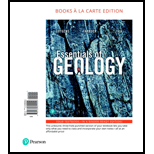
(a)
The type of volcano seen in the image and the features that were helpful in classification.
(a)
Answer to Problem 1GST
Since the volcano owes a large and symmetrical structure with steep apex region and gently steep flanks, it may be considered under the category of composite volcanoes.
Explanation of Solution
The alternate layering of cinders and ash that are erupted, interbedded lava flows with an almost symmetrical and large structure is a characteristic of a typical composite cone. Composite cones, also known as stratovolcanoes, are very active and exist in basaltic, andesitic, and at times rhyolitic compositions. They usually eject less fluid lava capable of covering a small distance.
The symmetrical and large morphological appearance of a composite volcano matches with the structure of volcano given in the image. Moreover, the volcano possesses gentle slopes and a steep apex portion, and thus can be taken as a composite volcano.
(b)
To describe: The eruptive style of the volcano seen in the image along with its magma composition and viscosity.
(b)
Answer to Problem 1GST
Generally, a typical composite volcano is very active and explosive and may be composed of “less fluid andesitic magma flows having alternating layers of pyroclasts and ash interbedded with lava flows that are fluid basaltic.”
Explanation of Solution
The alternate layering of cinders and ash that are erupted interbedded lava flows with an almost symmetrical and large structure is a characteristic of a typical composite cone. Because of this layered structure, they can also be called as stratovolcanoes.
Composite cones are usually considered as active and explosive ones with steep apex regions and gently sloping flanks that produce huge quantities of pyroclasts. The word “composite” becomes meaningful in case of this volcano, as it consists of both lava flows and pyroclasts.
Commonly, the composite cones are said to be products of silica-enriched magma having an andesitic composition. Yet, there are several composite cones that expel fluid basaltic lava and infrequently some may give off pyroclasts with a rhyolitic composition. Thus, it may be concluded that the composite cones from andesitic magma give viscous and thick lava capable of travelling not more than a few kilometers, whereas the fluid and less viscous lava from the composite cones of basaltic composition can travel longer distances.
(c)
To describe: The plate boundary associated with the type of volcano given in the image.
(c)
Answer to Problem 1GST
Convergent plate boundaries are involved in the formation of composite cones.
Explanation of Solution
The alternate layering of cinders and ash that are erupted interbedded lava flows with an almost symmetrical and large structure is a characteristic of a typical composite cone. Because of this layered structure, they can be also called as stratovolcanoes.
Composite cones are usually considered as active and explosive ones with steep apex regions and gently sloping flanks that produce huge quantities of pyroclasts. The word “composite” becomes meaningful in case of this volcano, as it consists of both lava flows and pyroclasts.
Generally, a typical composite volcano is very active and explosive and may be composed of “andesitic magma flows having alternating layers of pyroclasts and ash interbedded with lava flows that are basaltic.” They may have a less fluid but silica-rich, andesitic to rhyolitic composition.
The area with the largest number of composite volcanoes is situated in an active zone bordering the Pacific Ocean, which is given the name ‘Ring of Fire’. The Ring of Fire known for active volcanism encloses majority of the world’s active volcanoes. The Ring of Fire lies in the circum-Pacific belt, which is the convergence zone where the denser oceanic plate subducts beneath the less dense plate. Composite volcanoes are produced from the convergence of an oceanic plate and a continental plate.
(d)
To name: A city prone to the effects of the type of volcano shown in the image.
(d)
Answer to Problem 1GST
Washington’s Seattle is a city prone to the effects of a composite cone.
Explanation of Solution
Composite cones are usually considered as active and explosive ones with steep apex regions and gently sloping flanks that produce huge quantities of pyroclasts. The word “composite” becomes meaningful in case of this volcano, as it consists of both lava flows and pyroclasts. They are very destructive, in the sense that they produce pyroclastic flows, which are very deadly and mudflows.
Seattle, which is a seaport city in Washington, lies in the Pacific Ring of Fire, and hence it is susceptible to eruptive volcanism related to composite cones.
Want to see more full solutions like this?
Chapter 5 Solutions
Essentials of Geology, Books a la Carte Plus Mastering Geology with Pearson eText -- Access Card Package (13th Edition)
 Applications and Investigations in Earth Science ...Earth ScienceISBN:9780134746241Author:Edward J. Tarbuck, Frederick K. Lutgens, Dennis G. TasaPublisher:PEARSON
Applications and Investigations in Earth Science ...Earth ScienceISBN:9780134746241Author:Edward J. Tarbuck, Frederick K. Lutgens, Dennis G. TasaPublisher:PEARSON Exercises for Weather & Climate (9th Edition)Earth ScienceISBN:9780134041360Author:Greg CarbonePublisher:PEARSON
Exercises for Weather & Climate (9th Edition)Earth ScienceISBN:9780134041360Author:Greg CarbonePublisher:PEARSON Environmental ScienceEarth ScienceISBN:9781260153125Author:William P Cunningham Prof., Mary Ann Cunningham ProfessorPublisher:McGraw-Hill Education
Environmental ScienceEarth ScienceISBN:9781260153125Author:William P Cunningham Prof., Mary Ann Cunningham ProfessorPublisher:McGraw-Hill Education Earth Science (15th Edition)Earth ScienceISBN:9780134543536Author:Edward J. Tarbuck, Frederick K. Lutgens, Dennis G. TasaPublisher:PEARSON
Earth Science (15th Edition)Earth ScienceISBN:9780134543536Author:Edward J. Tarbuck, Frederick K. Lutgens, Dennis G. TasaPublisher:PEARSON Environmental Science (MindTap Course List)Earth ScienceISBN:9781337569613Author:G. Tyler Miller, Scott SpoolmanPublisher:Cengage Learning
Environmental Science (MindTap Course List)Earth ScienceISBN:9781337569613Author:G. Tyler Miller, Scott SpoolmanPublisher:Cengage Learning Physical GeologyEarth ScienceISBN:9781259916823Author:Plummer, Charles C., CARLSON, Diane H., Hammersley, LisaPublisher:Mcgraw-hill Education,
Physical GeologyEarth ScienceISBN:9781259916823Author:Plummer, Charles C., CARLSON, Diane H., Hammersley, LisaPublisher:Mcgraw-hill Education,





